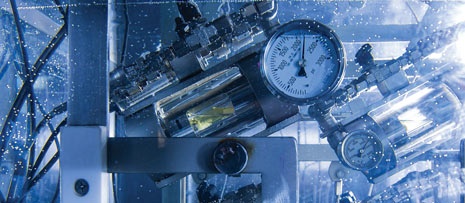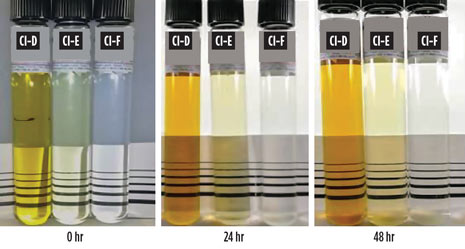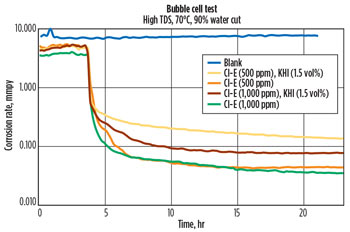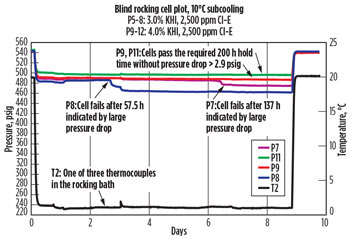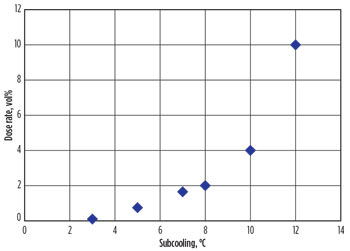Inhibitor package simplifies production chemistry in wet gas applications
PART 2—Both Kinetic hydrate inhibitors (KHIs) and compatible corrosion inhibitors (CIs) are water-soluble and contain surface-active components.
|
A novel dual-functional KHI and CI package was developed for use in wet gas applications. In the first part of this two-part article (November 2014), the background of the problem was explained, and performance testing of the Kinetic Hydrate Inhibitor part of the package was described. In this second and final part, five iterations of compatible corrosion inhibitor were tested, and results evaluated. Corrosion inhibitor qualification. The KHI/CI package was qualified for corrosion protection in a series of tests under sweet conditions by a standard set of testing protocols. These conditions included bubble tests, using a pre-corrosion protocol and rotating cage autoclave (RCA) coupon testing. The bubble tests were performed at 20°C and 70°C with both high (18%) and low (0.1%) TDS brines. The RCA experiments were performed at 30% water cut with the same temperatures and brines. Following completion, corrosion coupons were weighed to determine average corrosion rate, visually inspected for localized corrosion, and inspected by microscope for maximum pit depth and pit density. The RCA tests were conducted initially with a shear stress of 100 Pa, but then later revised to 200 Pa to further press the system. Accordingly, the treatment rate of CI-A was adjusted to 250 ppm, to meet the metric of a corrosion rate below 0.1 mmpy, and no localized attack in the presence of the KHI. Though CIs are injected at lower treatment rates compared to KHIs, they have the propensity to form and stabilize emulsion. Emulsion tendency tests utilizing high shear mixing were performed using synthetic brine, field condensate, and the CI only. In the laboratory experiments at 30% water cut, the CI was not observed to stabilize emulsion. In these experiments, the water-in-oil emulsion fully separated into distinct phases in less than five minutes following agitation. The operator required full separation within 10 min. Improved emulsion tendency. Upon further analysis with the full KHI/CI package, it was revealed that the emulsion tendency requirement was not met entirely. Previous experiments were performed in the absence of the KHI. Following high shear mixing for 3 min., the mixture containing both KHI and CI-A did not resolve into clear condensate and aqueous phases within 10 min. at ambient temperature, per the operator’s requirement. Due to the delicacy of the KHI formulation, it was more desirable to add a demulsifier component to the CI. Several demulsifier components were screened, and an emulsion breaker package was selected, herein referred to as CI-B. Based on the environmental requirements outlined by the operator, a demulsifier additive with appropriate government environmental rating was required. In verification experiments, CI-A and CI-B were compared at equivalent rates of 250 ppm in the presence of KHI. Figure 4 details the emulsion tendency results over a period of 1 hr.
Upon this improved result, CI-B was examined in the RCA coupon mass loss test at the increased shear rate of 200 Pa. The presence of the demulsifying component did not affect the performance of the parent formulation, and the 250-ppm minimum dosage rate was maintained. Corrosion inhibitor reformulation. The 80% dilution of the KHI in methanol was considered advantageous in many respects. The low viscosity of the dilute product afforded simple deliverability with the existing chemical injection system. As the KHI is dosed on vol% (1 vol% = 10,000 ppm) based on water, the CI treatment rate is only a fraction of that number at 250 ppm. Accordingly, the existing chemical pumps could not reliably deliver the low rate of 250 ppm CI-B. Delivery of the minimal rate of CI-B would still result in overtreatment. Due to the potential interference of CI on KHI performance, coupled with the fear of emulsion stabilization, a THI dilution solvent, mainly a methanol dilution of CI-B, was requested. Although it was hoped that a methanol dilution of CI-B would proceed seamlessly, the hydrophobic demulsifier component required to minimize emulsion stabilization had limited solubility in methanol. Due to this hazing phenomenon, a potential drawback for umbilical deployment, a 90% dilution of CI-B in methanol was not feasible. Alternative solvents were examined for the dilution process, and ethylene glycol monobutyl ether (EGMBE) was found optimal to maintain formulation integrity at low temperature and general physical properties. The inclusion of EGMBE did not significantly affect deliverability as the diluted product retained a moderate viscosity of 22.0 cP at 4°C and 20,000 psi. This new dilution of CI-B is herein referred to as CI-C. Accordingly, a 2,500-ppm dose rate of CI-C was examined in RCA and blind rocking cell tests to confirm that the inclusion of an increased amount of an organic solvent didn’t negatively affect corrosion and hydrate inhibition. In those performance tests, the dilution with EGMBE did not affect either corrosion or hydrate inhibition. As EGMBE is not as readily available, and hence more expensive, than methanol, this dilution was considered an interim solution. Though this solution bridged the gap to make the KHI/CI package field-ready, efforts were focused on the development of a new CI formulation, containing the optimized demulsifier. Methanol-compatible corrosion inhibitor development. An improved offering addressing all proposed metrics was developed. Initially, a CI product of standard activity, CI-D, was developed and qualified. Strategically, by proving methanol compatibility with a concentrated product, methanol formulations of various compositions could be achieved easily. Figure 5 highlights the initial study, proving methanol compatibility at dilution factors of 10 and 100 to afford new formulations, CI-E and CI-F, respectively. Note the absence of haze or precipitation, which is indicative of instability, in the dilution study at ambient temperature. The three new CI products underwent extended stability studies at several temperatures including –20°C, as well as standard umbilical certification, including centrifugation at 2,000 rpm and 4°C for 7 days.
As emulsion issues originally drove the change process for the related corrosion inhibitors, emulsion tendency screening with the proposed KHI/CI package was examined thoroughly. The standard emulsion protocol called for the shearing of field condensate and low TDS brine at 70% water cut by homogenizer at 5,000 rpm for 3 min. The KHI was dosed at 2.5vol%, and CI-E rates ranged from 250 to 4,000 ppm. Figure 6 details the emulsion tendency tests with the blank, KHI alone, and KHI/CI-E package (CI-E at maximum test dosage of 4,000 ppm). The test with no production chemicals indicates that the system does not inherently emulsify. The large volume of KHI in the system, in conjunction with high shear, appears to be the main perpetrator of the emulsion issues. In the experiment with KHI only, a large quantity of water-in-oil emulsion would not resolve upon standing at ambient temperature for 1 hr. Upon the introduction of CI-E at the rate of 2,500 ppm, the previous CI rate for corrosion and rocking cell performance tests, the emulsion typically broke within the first minute following high shear mixing to restore the quantitative volumes of field condensate and brine phases. At the maximum CI-E rates of 4,000 ppm, no negative impact on phase separation was noted.
Of particular interest to the operator was the quality of the condensate in the emulsion tendency tests. Slightly hazy water, due to the presence of chemical, was acceptable, but water-free condensate for export regulations was required. In addition to visual inspection, water content was determined by Karl-Fischer titration. For all CI-E dose rates examined, in the presence of KHI, water was below 0.01%. Final performance qualification. Extensive inhibitor testing under bubble cell and RCA protocols was performed with CI-E. As both low and high TDS conditions, as well as temperatures of 20°C and 70°C, were examined, the high-TDS, 70°C test temperature, and 90% water cut scenario represent the most severe conditions from a corrosion standpoint. Hence, Fig. 7 summarizes the results from this series of bubble cell experiments. In the absence of KHI, CI-E meets the less-than-0.1 mmpy corrosion rate metric at a dosage of 500 ppm. Upon the introduction of KHI, the dose rate of CI-E was increased to 1,000 ppm, to maintain the appropriate level of protection. RCA experiments confirmed the efficacy of the KHI/CI package. A CI-E treatment rate of 500 ppm, in the presence of the KHI, was effective at reducing the corrosion rate well below the maximum threshold. Additional white light surface analysis was performed on the resulting coupons, to confirm the absence of pitting. In a head-to-head performance comparison on the basis of activity, recall CI-E is a 90% methanol dilution in contrast to CI-A, the new inhibitor provides equivalent protection at a comparable rate.
As CI-E represented the offering that addressed all of the operator’s secondary property, chemical compatibility, and basic corrosion requirements, additional tests were performed, examining the robustness of the offering. Subsequent RCA experiments in which CI-E was aged for 24 hr at 90°C, as well as a separate KHI overtreatment scenario with KHI dosing at 10.0vol% afforded favorable results. In most experiments, the target corrosion rate of less than 0.1 mmpy was observed, or a slight increase in CI-E rate was required to account for the more strenuous conditions. With clear evidence that the CI met the operator’s corrosion requirements, compatibility tests in blind rocking cells were run in parallel. It was a pleasant discovery that CI-E was comparatively more compatible with the KHI than its predecessors. In blind rocking cell tests at 8°C sub-cooling and 2,500 ppm CI-E, the required KHI dose rate to exceed the minimum hold time requirement of 200 hr was found to be 2.0vol%. Recall that in the previous qualification of CI-A and CI-B, the KHI rate was 2.50vol%, hence a marked decrease in KHI treating rate. It is also important to recall that CI-E was qualified in the presence of the KHI at a rate of 1,000 ppm in bubble cell and RCA testing. Therefore, the KHI performance was confirmed under an approximate 2.5 times CI overtreatment scenario. As field application of the KHI/CI package was targeted for a number of wells over a linked subsea network, the condition of 8°C sub-cooling was considered the most severe expected field-wide for steady-state operation. Accordingly, with variations in flowline temperature, pressure, and produced water composition, it is quite feasible for sub-cooling to decrease in various places during steady-state operations. Recall that the requirement for the KHI formulation to contain 80% methanol was to ensure a dual functional hydrate inhibitor product, which could be utilized for the high sub-cooling conditions of cold well restarts and well start-ups, instead of pure methanol. With the KHI and CI-E packages in place, performance testing at elevated and reduced sub-coolings commenced. Figure 8 details a KHI performance test in the presence of 2,500 ppm CI-E at 10°C sub-cooling. In this experiment, a 4.0vol% KHI treatment rate was required to achieve four of four passes.
Upon implementation of the KHI for cold well starts-ups or restarts, the chemical would be subjected to extremely low temperatures. Stability testing of the KHI at –45°C for a period of 24 hr under static conditions revealed formulation stability by the absence of gelling, clouding, precipitation, and/or phase separation. The viscosity of the KHI at ambient pressure at –20°C was found to be approximately 3.0 cP. The combination of performance at elevated sub-cooling, low temperature stability, and low temperature viscosity gave the operator the confidence to apply the KHI as a true, dual functional inhibitor. To account for the potential sub-cooling variation, a general KHI dose rate versus sub-cooling curve was generated and distributed to the operator, to simplify field deployment. Figure 9 details this dosage guidance relationship, indicating the minimum KHI rate required to afford a minimum of 200 hr of hold time in performance tests.
Field applications. There are currently two active applications of the KHI/CI package and imminent plans for a third. Each subsequent application has taken the natural progression of increasing the demands on the chemical package from its predecessor. Additionally, with each unique application, laboratory qualification tests have been validated by field data. The first application has been operational for over 18 months and has enabled significant new (greenfield) production by allowing continuous production, under conditions of hydrate stability from two new high-pressure, subsea wells that were added to the brownfield production system. Sub-cooling of 8°C has been encountered routinely during the winter months when seafloor temperature drops to its annual minimum of nearly 4°C. As the final dose rate response curve was not yet completed during the CAPEX phase of this development, supplemental methanol was injected to protect at sub-coolings greater than 7°C. Vigilant monitoring of the operating sub-cooling upstream of the injection point, in the subsea pipeline, and topside before pressure reduction has ensured that times of higher risk operation at high sub-cooling are highlighted and avoided. During start-up, the oil-in-water values for water discharged to the sea were briefly affected by the introduction of the chemicals into the produced fluids. This was clearly linked to the high volume of methanol utilized for cold start-up, and after only a few hours, the oil-in-water specifications were again met consistently. A quantitative KHI residual method, in conjunction with process instrumentation and metering, has been utilized to confirm the accuracy of the KHI injection rate, as well as confirm the water-to-gas ratio (WGR) predictions of the new wells. The KHI brine and temperature compatibility parameters fit acceptably into current operating conditions, so the low-salinity produced water is injected into a re-injection well. The second application followed about one year later, with the similar concept of tying new high-pressure wells into existing brownfield production. In this scenario, no additional methanol injection capabilities were installed, which represented a significant CAPEX, deck space, and weight savings for the brownfield platform modification project. Following this decision, the dual functionality of the KHI was utilized for both steady-state operation and cold well start-ups or restarts. Due to the low pressure of the existing wells, and a lower-than-expected flowing pressure from the new high-pressure well, the system did not require continuous hydrate inhibition. However, during cold start-up, the temperature downstream of the topside choke drops to –20°C. During restarts in winter, this temperature drops to a minimum of –35°C. The methanol content of the KHI formulation was taken into account to calculate an adjusted chemical dose rate for thermodynamic hydrate and ice inhibition. This practice was deemed successful. The large volumes of KHI introduced into the system for cold well start-ups were a concern for the separation trains on the receiving platform. A laboratory emulsion tendency study, examining KHI concentration of up to 70vol% in the presence of CI, and under conditions of high shear and ambient temperature, indicated that there should not be a significant effect on condensate and water separation. A field monitoring program and showed that this was the case. No deviations in oil-in-water values overboard have been experienced following cold well startups. Summary. A novel dual-functional KHI and CI package was developed for use in wet gas applications. The high-performing KHI was specially formulated with 80% methanol, so that it could be employed as a standard KHI during steady-state production but alternatively as a thermodynamic inhibitor during shut-in and restart scenarios, as well as meet several secondary property requirements. Notably, the solubility profile of the KHI was examined thoroughly and determined to be compatible with the potential range of temperature and brine salinities. Due to the delicacy of the KHI formulation, five iterations of CI offerings were required to address application challenges, including the development of a new chemistry entirely. All five iterations were robust in maintaining corrosion rates below the target 0.1 mmpy, as well as preventing localized attack. The sequential CI offerings skillfully addressed issues of emulsion and required dilution to present a compatible KHI/CI package, which afforded a 0.50vol% reduction in minimum KHI dose rate compared to the originally qualified package. The pairings of these KHI/CI packages have been successfully applied in the field are being considered for future applications. ACKNOWLEDGEMENTS This article was adapted from a paper presented at the Offshore Technology Conference Brazil, held in Rio de Janeiro Oct. 29–31, 2013. The authors thank Nalco Champion for permission to publish this work. Additional appreciation is extended to Robert Bruce, Bert Schiffmacher and Kevin McNamee of Nalco Champion, as well as Jennifer Jackson and Peter Conrad, for their contributions toward the success of this project. REFERENCES
|
- What's new in production (February 2024)
- Subsea technology- Corrosion monitoring: From failure to success (February 2024)
- U.S. operators reduce activity as crude prices plunge (February 2024)
- U.S. producing gas wells increase despite low prices (February 2024)
- U.S. oil and natural gas production hits record highs (February 2024)
- Dallas Fed: E&P activity essentially unchanged; optimism wanes as uncertainty jumps (January 2024)
- Applying ultra-deep LWD resistivity technology successfully in a SAGD operation (May 2019)
- Adoption of wireless intelligent completions advances (May 2019)
- Majors double down as takeaway crunch eases (April 2019)
- What’s new in well logging and formation evaluation (April 2019)
- Qualification of a 20,000-psi subsea BOP: A collaborative approach (February 2019)
- ConocoPhillips’ Greg Leveille sees rapid trajectory of technical advancement continuing (February 2019)

